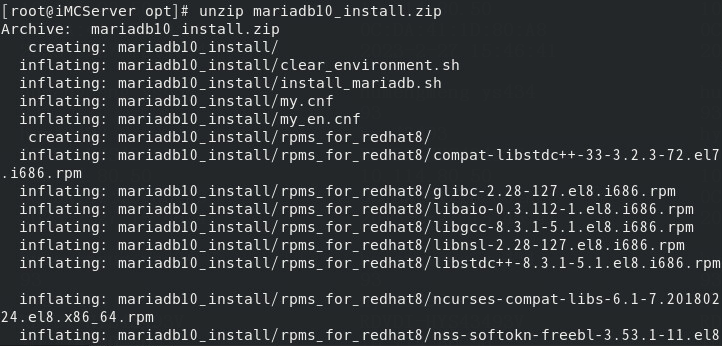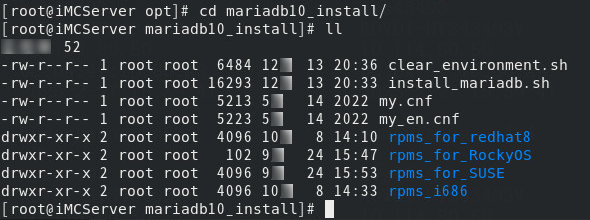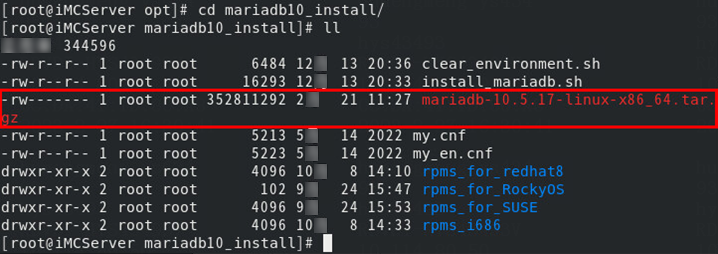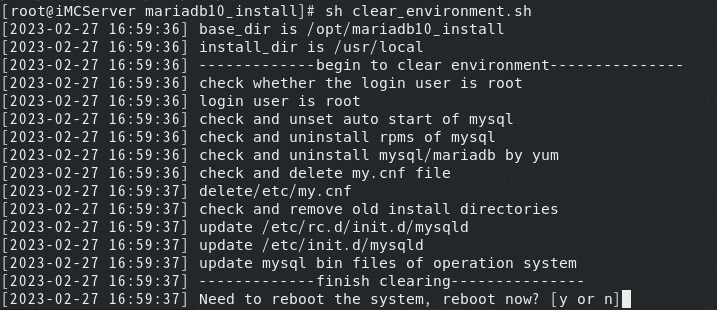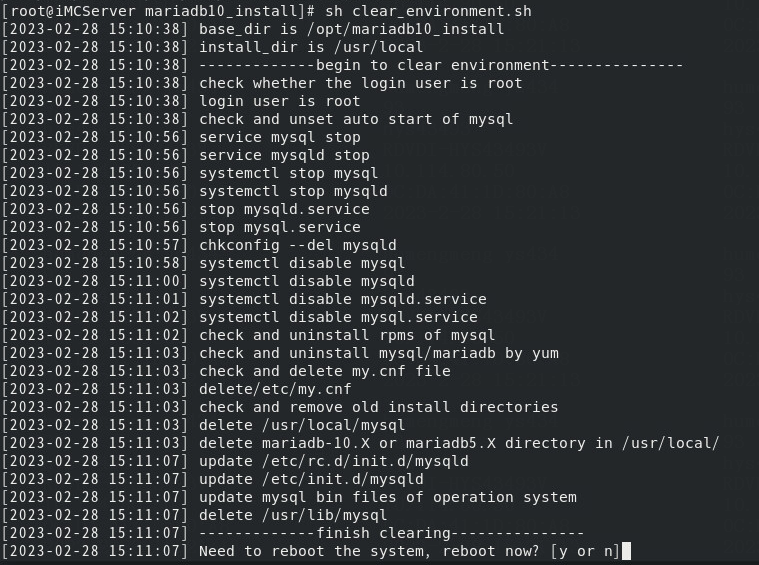- Table of Contents
-
- H3C iMC Database Installation Guide-5W103
- 01-MySQL 8.0.xx Installation and Configuration Guide (for Linux)
- 02-MySQL 8.0.xx Installation and Configuration Guide (for Windows)
- 03-Oracle 11g Installation and Configuration Guide
- 04-Oracle 11g R2 Installation and Configuration Guide
- 05-Oracle 12c Installation and Configuration Guide
- 06-Oracle 12c R2 Installation and Configuration Guide
- 07-Oracle 18c Installation and Configuration Guide
- 08-SQL Server 2016 Installation and Configuration Guide
- 09-SQL Server 2017 Installation and Configuration Guide
- 10-SQL Server 2019 Installation and Configuration Guide
- 11-SQL Server 2022 Installation and Configuration Guide
- 12-MariaDB 10.x.x Installation Guide (Linux)
- 13-MariaDB 10.x.x Installation Guide (Windows)
- Related Documents
-
| Title | Size | Download |
|---|---|---|
| 12-MariaDB 10.x.x Installation Guide (Linux) | 1.97 MB |
|
|
|
|
|
MariaDB 10.x.x |
|
Installation Guide (Linux) |
|
|
|
|
|
New H3C Technologies Co., Ltd. http://www.h3c.com
Document version: 5W100-20250415 Software version: IMC PLAT 7.3 (E0706) |
Copyright © 2025 New H3C Technologies Co., Ltd. and its licensors. All rights reserved.
No part of this manual may be reproduced or transmitted in any form or by any means without prior written consent of New H3C Technologies Co., Ltd.
Except for the trademarks of New H3C Technologies Co., Ltd., any trademarks that may be mentioned in this document are the property of their respective owners.
The information in this document is subject to change without notice. All contents in this document, including statements, information, and recommendations, are believed to be accurate, but they are presented without warranty of any kind, express or implied. H3C shall not be liable for technical or editorial errors or omissions contained herein.
Preface
This document includes the following topics:
· Introduction—Introduces MariaDB versions and usage guidelines.
· Installation—Introduces the installation procedure of MariaDB.
· Uninstallation—Introduce the uninstallation procedure of MariaDB.
This preface includes the following topics about the documentation:
· Audience
Audience
This documentation is intended for:
· Network planners.
· Field technical support and servicing engineers.
· Network operators, administrators, and maintainers.
Conventions
The following information describes the conventions used in the documentation.
GUI conventions
|
Convention |
Description |
|
Boldface |
Window names, button names, field names, and menu items are in Boldface. For example, the New User window opens; click OK. |
|
> |
Multi-level menus are separated by angle brackets. For example, File > Create > Folder. |
Symbols
|
Convention |
Description |
|
An alert that calls attention to important information that if not understood or followed can result in personal injury. |
|
|
An alert that calls attention to important information that if not understood or followed can result in data loss, data corruption, or damage to hardware or software. |
|
|
An alert that calls attention to essential information. |
|
|
NOTE: |
An alert that contains additional or supplementary information. |
|
An alert that provides helpful information. |
Documentation feedback
You can e-mail your comments about product documentation to [email protected].
We appreciate your comments.
Introduction
This document describes the installation and configuration procedures of the MariaDB 10.x.x database when it is used with H3C Intelligent Management Center (IMC), as well as the restrictions and guidelines.
This document uses Red Hat Enterprise Linux 8.7 (RHEL 8.7) and MariaDB 10.5.7 as examples to describe the procedure of using an installation script to install MariaDB 10.5.7 on the Linux operating system.
Installation
Prepare the installation package before installation
1. Download the MariaDB installation package from the official website of MariaDB, as shown in Figure 1:
|
|
NOTE: · To display all versions, select the Display older releases option. · From the Init System list, select either Systemd or Sysvinit. |
Figure 1 Official website of MariaDB
2. This guide provides a database installation script that allows you to complete the installation of the MariaDB database through only executing the script.
|
|
NOTE: · The database installation script provided in this guide only supports installing the x86 version of the MariaDB database. · The database installation script provided in this guide only supports the following operating systems: Red Hat 7.x, Red Hat 8.x, CentOS 7.x, Kylin v10, Red Flag Linux 7.3, Linx Rocky 6.0.80, SUSE 12.2, and SUSE 12.5. All these operating systems support deployment through either the default path or the specified path. · You can obtain the database installation script from the download page for this installation guide. For more information, see "How can I obtain the required toolkit on the whole book download page?." |
Installation procedure
|
WARNING! For a non-root user, first execute the su root command to grant root user permissions to the user before performing the following steps. The following example describes how to install the MariaDB database as the root user. |
1. Upload the one-click installation package mariadb10_install.zip to the /opt/ directory in the Linux operating system.
2. Execute the following commands to access the /opt directory and verify that the file is successfully uploaded, as shown in Figure 2.
[root@iMCServer ~]# cd /opt
[root@iMCServer opt]# ll
Figure 2 View the installation package
3. Execute the following commands to decompress the installation package and identify whether the decompression process is successful, as shown in Figure 3 and Figure 4.
[root@iMCServer opt]# unzip mariadb10_install.zip
[root@iMCServer opt]# ll
Figure 3 Decompress the installation package (1)
Figure 4 Decompress the installation package (2)
4. Execute the following commands to access the mariadb10_install folder and view all files in the folder, as shown in Figure 5.
[root@iMCServer opt]# cd mariadb10_install/
[root@iMCServer mariadb10_install]# ll
Figure 5 View the installation files
|
CAUTION: To use the EIA component, you must edit the configuration file named my.cnf/my_en.cnf and identify whether the transaction_isolation configuration item exists under the [mysqld] configuration. If yes, modify the value for the configuration item to READ-COMMITTED. If not, add the transaction_isolation=READ-COMMITTED configuration to the configuration file. |
5. (Optional.) Specify the MariaDB installation directory. MariaDB is installed in the /usr/local directory by default. However, you can specify a different installation directory as needed. To specify an installation directory, modify the value for the install_dir field in the script file named install_mariadb.sh in the /opt/mariadb10_install directory of the Linux operating system, as shown in Figure 6.
Figure 6 Specify the MariaDB installation directory
6. Upload the MariaDB installation package downloaded from the official website to the /opt/mariadb10_install/ directory, as shown in Figure 7.
Figure 7 View the installation package
7. Execute the following command to clear the environment. After you clear the environment, you must restart the operating system. Enter y to restart the operating system immediately, or enter n to manually restart the operating system later, as shown in Figure 8.
[root@iMCServer mariadb10_install]# sh clear_environment.sh
Figure 8 Clear the environment
8. Execute the following command to execute the installation script to start installing MariaDB, as shown in Figure 9.
[root@iMCServer mariadb10_install]# sh install_mariadb.sh
Figure 9 Start installing MariaDB
9. Enter the language for database installation as prompted, as shown in Figure 10.
¡ If you select cn (Chinese), the database in Chinese will be installed, and the database character set will be set to gbk. In this case, the configuration file named my.cnf is used.
¡ If you select en (English), the database in English will be installed, and the database character set will be set to Latin1. In this case, the configuration file named my_en.cnf is used.
Figure 10 Select the database language
10. Enter a custom database password as prompted, as shown in Figure 11.
Figure 11 Set the database password
11. After the installation is completed, restart the operating system as prompted, as shown in Figure 12.
Figure 12 Installation completed
Verify connectivity
After you install the MariaDB client, identify whether it can correctly connect to the MariaDB server.
IMC with local database
The IMC server has the MariaDB server installed. After the client is installed, execute the following command, and enter the root user password after the Enter password: field. If you can access the MySQL command line interface (CLI), the database is operating correctly.
[root@iMCServer mariadb10_install]# mysql –uroot –p
Figure 13 Test the database
IMC with remote database
After the client is installed on the IMC server, execute the command shown in the following figure to identify whether the client can correctly connect to the MariaDB server. In this command, 192.167.240.80 is the IP address of the MariaDB server. Enter the root user password after the Enter password: field.
If you can access the MariaDB CLI, the client can correctly connect to the database.
Figure 14 Verify the connection to the MariaDB server
Start/stop
Start/stop commands
After MariaDB is installed, it is automatically configured as a system service. Therefore, you can start and stop the MariaDB service by using service commands.
[root@iMCServer mariadb10_install]# systemctl start mysqld
[root@iMCServer mariadb10_install]# systemctl stop mysqld
Figure 15 Start command
Figure 16 Stop command
Uninstallation
Log in to the system as the root user and execute the following command to uninstall the MariaDB database:
[root@iMCServer ~]# cd /opt
[root@iMCServer opt]# cd mariadb10_install/
[root@iMCServer mariadb10_install]# sh clear_environment.sh
|
CAUTION: After you execute the uninstallation script, restart the operating system. Select y to automatically restart the operating system immediately, or select n to manually restart the operating system later. |
FAQ
How can I obtain the required toolkit on the whole book download page?
1. Access https://www.h3c.com/en/ and then select Support > Technical Documents.
2. Select Network Operations & Management, and then click Intelligent Management Center 7 under Intelligent Management Center to access the H3C intelligent management center document library.
3. Hover over the target document name. Then,
the ![]() icon will appear after the document name. Click the
icon will appear after the document name. Click the ![]() icon to download and obtain the required toolkit, as shown in Figure 17.
icon to download and obtain the required toolkit, as shown in Figure 17.
|
TIP: This section mainly describes how to obtain the toolkit on the whole book download page. See the actual download results for the specific toolkit required. The content below is provided as an example only. |
Figure 17 Download page for the whole book



